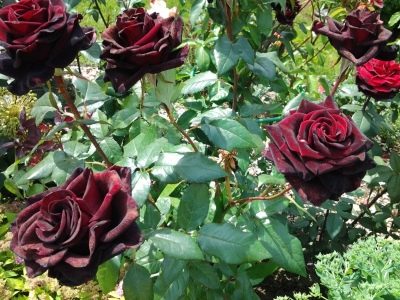
- Authors: Tantau
- Name synonyms: Barkarole, TANelorak, Taboo, Grand Chateau
- Breeding year: 1988
- Group: tea-hybrid
- The main color of the flower: red
- Flower shape: classic, goblet
- Flower size: large
- Diameter, cm: 7-8
- Flower type by number of petals: thick double
- Scent: pleasant
The popular variety of roses called Barcarole wins fans with its elegant appearance - wine-colored flowers on long legs. The variety was bred in Germany in 1988.
Description of the variety
The Barcarole rose variety, which belongs to the hybrid tea group, is also known by other names: Barkarole, Taboo, Grand Château and TANelorak. The height of a medium-sized compact bush with an erect black and red stem is about 70 centimeters in cold climates and 80-100 centimeters in hot regions and greenhouses, and the width does not exceed 60-80 centimeters. The plant forms quite vigorous, but not spreading. The branches are covered with dense large leaves that change color from red to dark green.
The diameter of the open buds is 7-8 centimeters. Densely double flowers have a graceful goblet shape, and their long velvety petals are colored dark red, almost black. They can grow both singly and in inflorescences. The presence of long shoots on which the buds sit makes the cultivar ideal for cutting, but keep in mind that the aroma of Barcarole is not particularly bright, but very delicate.
Advantages and disadvantages
The Barcarole variety has good immunity, which provides the plant with protection against common diseases: black spot, powdery mildew and various fungi. The rose has practically no thorns, the buds do not fade in the sun and stick well to the stems. Flowers retain their decorative effect throughout the season. It is also necessary to mention the fact that they stand for a long time after cutting. The disadvantage of the culture can be called an average frost resistance, which allows it to withstand cold snaps only up to -18 ... 23 degrees.
In more severe conditions, the plant will definitely need to be covered. It should also be mentioned that the bush is sometimes formed uneven, or even just lopsided, so it has to be grown not to decorate the site, but only for cutting. Rose Barcarole also responds poorly to stagnant moisture in the soil.
Flowering features
Rosa Barcarole is re-flowering, that is, its flowering occurs in several stages with small intervals. It begins in the summer and continues until the fall. The flowering intensity of this variety is very abundant. It is also worth mentioning that in cooler climates, the rose exhibits a brighter color.
Landing
It is recommended to plant Barcarole roses in a well-lit area, protected from drafts. In the southern regions, the place should be selected in such a way that the plant is in the shade in the afternoon. Otherwise, burns may occur on the petals. The soil of the culture requires fertile, air and water permeable, as well as with good drainage. Slightly acidic loams enriched with humus are ideal for the plant.
We must not forget that roses react poorly to stagnation of both air and water. In no case should they be planted in beds with a close occurrence of groundwater, as well as in the vicinity of plants affected by powdery mildew. Heavy loams are preliminarily improved by adding humus, peat, sand or compost. The optimum acidity of the earth is 5.6-6.5 pH.
Barcarole should be planted in the spring - in April or May. In principle, planting can be organized in the fall, but only in a short time, so that the plants have time to take root. Approximately a week or two before the procedure, the soil is dug up together with humus, and a mineral complex containing nitrogen, phosphorus and potassium is applied to the site. For each plant, a hole is dug up to 60 centimeters deep. At its bottom, a drainage layer 10 centimeters thick is formed, and organic matter is introduced on top - rotted manure or compost, forming a layer of the same thickness.
A small mound is formed on top, on which a seedling is installed, previously aged for 24 hours in a growth stimulator. The roots are gently straightened, the voids are filled with earth, and the surface is compacted. After planting, the bed is abundantly irrigated and mulched.
Growing and caring
Barcarole roses thrive in temperate climates. The culture is not afraid of either heat or rainfall, and in general requires fairly simple maintenance. Watering should be regular, since sufficient soil moisture is a guarantee of rapid development of the crop, but still moderate. The intensity of watering increases during flowering, then decreases by autumn, and completely stops by mid-September.
It is customary to feed the rose 3-4 times per season. For this purpose, it is best to use ready-made mineral complexes diluted in water according to the instructions. In the spring, the plant requires formulations with a predominance of nitrogen, and before the formation of buds and during flowering, phosphorus-potassium mixtures. In the fall, the culture should be fertilized with drugs, in which phosphorus plays the leading role. During budding, you can arrange foliar feeding with magnesium, boron and manganese. Not only leaf blades should be sprayed, but also forming buds.
To maintain the aesthetics of the bush throughout the season, it is necessary to cut off the faded buds in a timely manner. The soil under the bush should be weeded regularly and loosened very carefully. During the season, those shoots that thicken the bush are cut off.































































